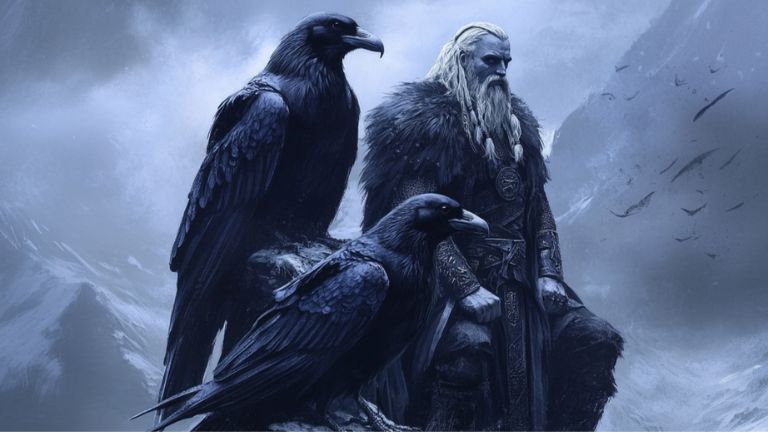
Odin's ravens Hugin and Munin: Guardians of wisdom
Split
In Norse mythology, animals are often more than just companions of the gods; they are symbols of power, wisdom, and the inseparable connection between the worlds. Among these legendary creatures, Odin's ravens, Hugin and Munin , stand out. These two winged messengers are not only a sign of Odin's omniscience, but also fascinating figures deeply rooted in Norse mythology.
The meaning of the names
The names Hugin and Munin come from Old Norse:
- Hugin means “thought” or “spirit”.
- Munin means “remembrance” or “memory”.
These meanings reflect Odin's quest for knowledge and understanding. They symbolize the dualism of intellect and memory that forms the basis of wisdom.
The Role of the Ravens
Odin, the Allfather and King of the Gods, is known for his insatiable thirst for knowledge. Hugin and Munin are his eyes and ears in the nine worlds of Norse mythology. Every morning, Odin sends the two ravens out to fly over the worlds and gather information.
In the evening they return and tell him what they have seen and heard. This keeps Odin informed about everything that is happening in the world - from the events in Midgard (the world of men) to the intrigues in Asgard (the world of the gods).
symbolism of ravens
The ravens are more than just messenger animals; they have a deeper symbolic meaning:
-
Wisdom and Knowledge:
Hugin and Munin represent Odin's access to infinite knowledge and his ability to see into the future.
-
Thought and memory:
These two aspects are essential for understanding the past and planning the future.
-
Protection and monitoring:
The ravens serve Odin as omnipresent observers who help him maintain order in the worlds.
-
Death and Transformation:
In many cultures, ravens are associated with death and change. As companions of Odin, who is also worshipped as the god of the dead, they embody the transition between life and death.
Hugin and Munin in Nordic Literature
The ravens are mentioned in several Norse texts, including the famous Edda . One of the most famous passages comes from the Grímnismál , a poem in which Odin himself speaks:
"Hugin and Munin
fly every day
across the wide world.
I worry about Hugin,
that he does not return,
but I am more worried about Munin.”
This quote shows Odin's concern for his messengers, especially Munin, which may suggest that memory is more fragile than thought.
representations in art and culture
The two ravens are a recurring motif in Nordic art and modern adaptations. They appear on runestones, in medieval manuscripts and in contemporary artwork.
Hugin and Munin also find their place in pop culture:
- In the Marvel film series “Thor” they appear as subtle companions of Odin.
- They play an important role in the video game series Assassin's Creed Valhalla and God of War .
Hugin and Munin: More than just animals
What makes Hugin and Munin so fascinating is that they represent the connection between Odin's divine power and the mortal worlds. They are not only symbols of knowledge and surveillance, but also a reminder that thought and memory are the foundation of all wisdom.
Their daily travels across the nine worlds show that knowledge is not static. It must be constantly sought, cultivated and preserved.
Conclusion
Hugin and Munin are more than just mythical ravens; they are a timeless symbol of the power of knowledge and the importance of memory and intellect. Their stories inspire us to remain curious, seek wisdom, and never forget what makes us who we are.
These faithful companions of Odin remind us that thoughts and memories must work together to achieve deeper wisdom – be it in Norse mythology or in our daily lives.




